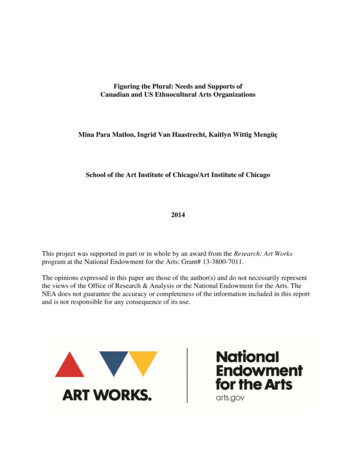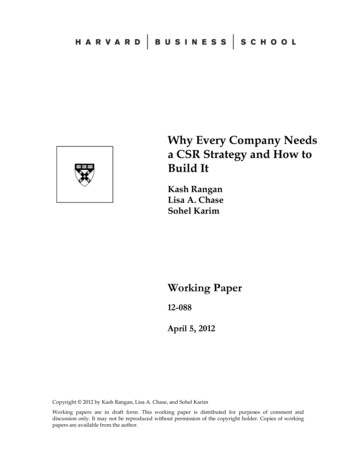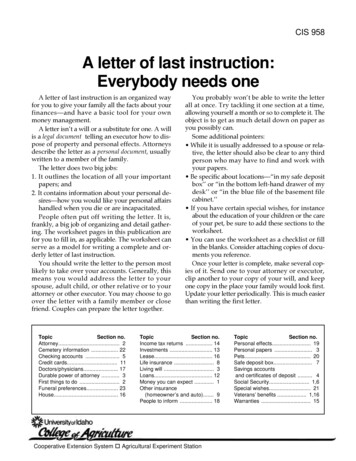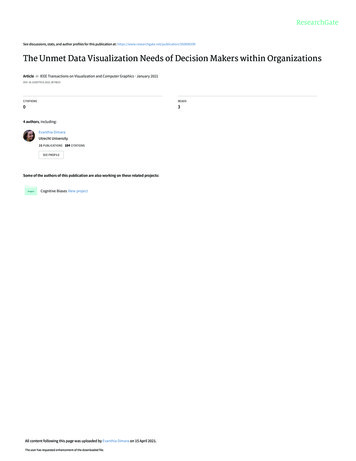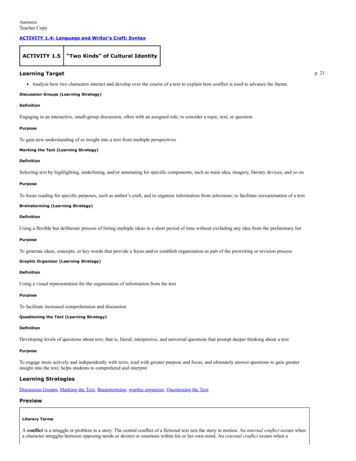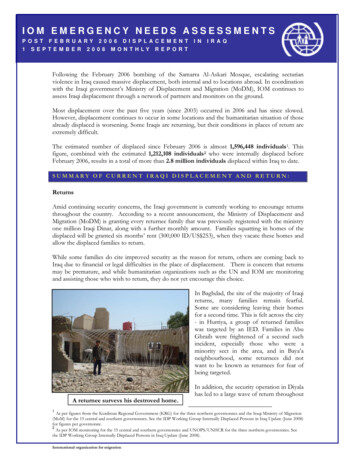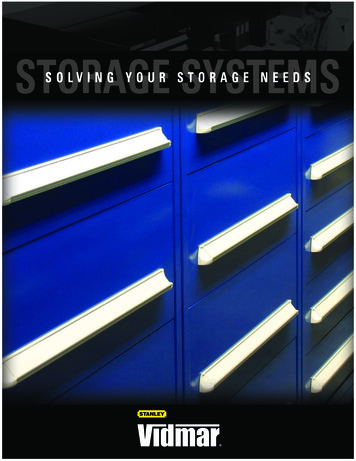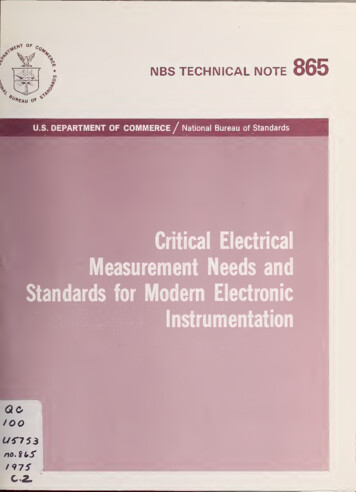
Transcription
%NBS TECHNICAL NOTE.4'iiv 865J\9 "H:AU OfU.S.DEPARTMENT OF COMMERCE/National Bureau of Standardsritical ElectricalMeasurement Needs and1for/ooUf7539915ModernElectronic
NATIONAL BUREAU. OF STANDARDSThe National Bureau of Standards was established by an act of Congress March 3, 1901.The Bureau's overall goal is to strengthen and advance the Nation's science and technology1andTofacilitate their effective application for public benefit.Bureau conductsthis end, theresearch and provides: (1) a basis for the Nation's physical measurement system, (2) scientificand technologicaland (4) technicaland government, (3) a technical basis for equity in trade,promote public safety. The Bureau consists of the Institute forBasic Standards, the Institute for Materials Research, the Institute for Applied Technology,the Institute for Computer Sciences and Technology, and the Office for Information Programs.services for industryservices toTHE INSTITUTE FOR BASIC STANDARDSprovides the central basis within the Unitedand consistent system of physical measurement; coordinates that systemwith measurement systems of other nations; and furnishes essential services leading to accurateand uniform physical measurements throughout the Nation's scientific community, industry,and commerce. The Institute consists of a Center for Radiation Research, an Office of Measurement Services and the following divisions:States of a completeApplied MathematicsSciences"——and Frequency*— Mechanics — Heat — Optical Physics — Nuclear— Quantum Electronics — Electromagnetics — TimeElectricityApplied Radiation'-'33— Laboratory Astrophysics — Cryogenics"THE INSTITUTE FOR MATERIALS RESEARCH".conducts materials research leading toimproved methods of measurement, standards, and data on the properties of well-characterizedmaterials needed by industry, commerce, educational institutions, and Government; providesadvisory and research services to other Government agencies; and develops, produces, andstandard reference materials. The Institute consists of the Office of StandardReference Materials and the following divisions:distributesAnalyticalRadiationChemistry — Polymers —— Physical Chemistry.Metallurgy——Inorganic MaterialsReactorTHE INSTITUTE FOR APPLIED TECHNOLOGYprovides technical services to promotetechnology and to facilitate technological innovation in industry andGovernment; cooperates with public and private organizations leading to the development ofthe use of availabletechnological standards (including mandatory safety standards), codes and methods ofand provides technical advice andconsists of a Center for Buildingservices toGovernment agencies uponrequest.Technology and the following divisions andThetest;Instituteoffices:— Weights and Measures — Invention and Innova— Product Evaluation Technology — Electronic Technology — Technical Analysis— Measurement Engineering —— BuildingMaterials, and Life SafetyEnvironment — Technical Evaluation and Application — Fire Technology.Engineering and Product Standardstion4Structures,**THE INSTITUTE FOR COMPUTER SCIENCES AND TECHNOLOGYconducts researchand provides technical services designed to aid Government agencies in improving cost effectiveness in the conduct of their programs through the selection, acquisition, and effectiveutilization of automatic data processing equipment; and serves as the principal focus withinthe executive branch for the development of Federal standards for automatic data processingequipment, techniques, and computer languages. The Institute consists of the followingdivisions:ComputertionServices— Systems and Software — Computer Systems Engineering — Informa-Technology.THE OFFICE FOR INFORMATION PROGRAMSpromotes optimum dissemination andand other agencies of the FederalGovernment; promotes the development of the National Standard Reference Data System anda system of information analysis centers dealing with the broader aspects of the* Nationalaccessibility of scientific information generated withinMeasurement System; provides appropriateaccessibilityto the scientificNBSservices to ensure that theNBSstaffhas optimuminformation of the world. The Office consists of the followingorganizational units:Office of Standard ReferencePublications—Library—Data— Office of InformationOffice of International1 Headquartersand Laboratories at Gaithersburg,Washington, D.C. 20234.3 Part ofthe Center for Radiation Research.a Locatedat Boulder, Colorado 80302.« Part of the Center for Building Technology.Activities— Office of mailingaddress
"MBical ElectricalMeasurement Needs andStandards for Modern Electronic Instrumentation' K «*L «tnaL.-Report of a Workshop Sponsored by theNational Bureau of StandardsGaithersburg, MarylandSeptember 23-24, 1974Edited byPeter Richman, Consulting EngineerLexington, Massachusetts 021736 0F c *CO U.S.DEPARTMENT OF COMMERCENATIONAL BUREAU OF STANDARDS,IssuedMay 1975RichardW.Roberts, Director
Workshop onCritical Electrical MeasurementNeeds and Standards for Modern ElectronicInstrumentationGaithersburg, Maryland, Sept. 23-24,1974Chairman: Barry N. Taylor, Chief, Electricity DivisionModerator: Peter Richman, Consulting EngineerChairmen, Working Sub-GroupsE. F. Boeckmann, Angstrohm Precision, Inc.D. E. Lawrence, Hewlett-Packard CompanyD. R. Ludwig, Teledyne PhilbrickF. B. Seeley, U S Army, Redstone ArsenalContributing AuthorsW.G. Eicke, B. F. Field, R. E. Kleimann, J. J. Morrow,N. M. Oldham, R. S. Turgel, H. K. Schoenwetter, T. M. SoudersElectricity Division, Institute for Basic StandardsNational Bureau of Standards, Washington, D.C. 20234Library of Congress Catalog Card Number:75-600022National Bureau of Standards Technical Note 865Nat. Bur. Stand. (U.S.), Tech.Note865, 74 pages(May1975)CODEN: NBTNAEU.S.GOVERNMENT PRINTING OFFICEWASHINGTON:Forsale1975by the Superintendent of Documents, U.S. Government Printing Office, Washington, D.C. 20402(Order by SD Catalog No. 03.46:865).Price 1.35
AbstractRecognizing the proliferation of sophisticated modern electronic instrumentation in the field ofmeasurements, the Electricity Division of the National Bureau of Standards recently initiated a new program in the general area of dynamic measurements and standards in support of suchinstrumentation. Recognizing further that the vastness and complexity of the field would require, atthe earliest stages of the program, identification of the most critical problem areas, the ElectricityDivision held a workshop on 23 and 24 September, 1974, at the Bureau's Gaithersburg site, to assistThe basic idea of the Workshop was to bringit in ascertaining just what these areas in fact were.together a broadly representative group of some twenty-five leading manufacturers and prime users,working in a free and open atmosphere, in order to have them delineate the present and future critical support needs in the field of dynamic electrical measurements for modern electronic instrumentation, with emphasis on physical standards, standardized measurement methods, new calibrationand measurement assurance services, relevant data, and most important, new measurement methodologies. The overall objectives of the Workshop were generally met, and a number of significantspecific; programs and projects consistent with the mission of the Electricity Division were identified. Three categories broadly cover the needs as defined at the Workshop:electrical1.The need to introduce time as a measurement parameter has resulted from the requirements of automatic test and control systems. Specific areas considered critical are:a.b.c.2.Pulsed component measurements.Dynamic performance characterizationfor modern signal conditioning and data conversion devices: Digital-to-analog and analog-to-digital converters, sample-andhold amplifiers, comparators, etc. Required measurements include settling, aperture and acquisition times. Basic new capabilities will be needed, including precision, non- sinusoidal waveform generation and "standard" digital-to-analog converters.Methodologies and techniques for characterizing precision AC and DC sources andmeasurement devices with respect to settling time.The emergence of measurements into the "real -world" or the production line via theautomatic system has introduced a host of new parameters. Areas requiring significanteffort include:a.b.c.d.e.f.g.h.3.Investigation of transportable standards for validation of static and dynamic systemperformance: AC and DC voltage, impedance, pulses, settling times.Techniques for characterizing sources and measurement devices with respect toswitched or dynamic loading.Prediction of long-term performance, reliability and lifetime from short-termevaluation for a host of passive components, semiconductors, and signal sources.Noise standards and methodologies.Continuing effort to improve transportable DC standards, and dissemination athigher voltage levels.Characterization of the AC line voltage - waveforms, under- and over-voltages,transients, dynamic impedance, etc.Inclusion of a capability for environmental control and variation for devices andinstruments under calibration, in all new work undertaken by the Bureau.Extension of Measurement Assurance Programs (MAP's), especially into the abovenew areas.Recent workat the leadingedge of measurement technology in electronics has resultedaccuracy measurements. For example:in the need for new, or higherin
a.Increased dependence on capacitors as storage devices has made dielectric hysteresis a parameter of importance. Significant measurement work should be started inthis area.b.Phase difference measurements to extremely high accuracies are needed to calibrateindustrial instrumentation.c.d.e.Higher accuracy power measurements, particularly for non- sinusoidal waveforms,are needed to calibrate instrumentation used in the field.Non- sinusoidal, high crest-factor precision signals are needed to calibrate true RMSconverters and meters.High accuracy electronic instrumentation requires reduction in AC calibration uncertainties to 10 ppm, at least over the audio range.Longer-term, "frontier" areasineach of the above groups were also identified. They are notwork at still more basic levels, on ground that isspecified in the above listings since they involvepresently terra incognita. Nevertheless, they furnish insight into the overall technical/philosophicclimate, and are useful for that reason. Items in this category include:1.Measurement problemsinsystems, including effects of history, measurement interac-tions, self- calibration, etc.2.3.4.5.6.7.8.Evaluation and standardization of system software.Calibration of medical equipment.Replacement of standard cells.Replacement of thermal AC/DC converters.Non-swept but broad -response measurements - impulse, noise, other.Basic work on the physics of dielectric absorption; component drift; device noise; failuremechanisms; switches and relays.Provision of improved measurement accuracy for virtually all dynamic measurements, atthe wafer probe level.In addition to the identification of these specific and general needs, the Workshop providedstrong evidence that both the manufacturing and user communities in the electronic instrumentationfield look to the Electricity Division to provide the technological leadership in these newer areas thatIndeed, there wasit has previously furnished in the more traditional electrical measurement areas.a good deal of support for the idea of keeping the electronics community informed of Division workin-progress, with emphasis on projects targeted by the Workshop.Keywords:Data conversion; dynamic measurements; electrical measurements;electronic instrumentation; signal conditioning; systems; time domain.IV
ForewordThe National Bureau of Standards (NBS) is becoming increasingly aware that its measurementservices, related research and other activities must be oriented towards the solution of the measurement community's "real-world" problems if NBS wishes to make a significant contribution tomeeting the country's needs in those areas containing a large scientific and technological component,for example, increased productivity and foreign trade, environmental pollution control, improvedhealth care delivery, solution of the so called "energy crisis", etc. The Electricity Division particularly recognizes the increased burden this new awareness places upon it, especially in the area ofmeasurement and standards support for modern electronic instrumentation, since such instrumentation is rapidly becoming all pervasive and a key element in the solution of our society's most critical technical problems.Inkeeping with this point of view, and the current trend in electrical measurements towardsthe wide utilization of electronic instrumentation, often in conjunction with digital computers, andmoremeasurements in the time domain, the Division has established overprogram in the general area of dynamic measurements and standardsoften than not high speedthe last year or so a nascentmodern electronic instrumentation. Present activities include development of a computer-basedsampling watt- system; new methods for accurate phase angle measurements; calibration and supportmethods for DC calibrators; characterization and calibration of solid state voltage sources and dissemination of the unit of voltage at levels higher than one volt; static and dynamic test sets for characterizing analog-to -digital and digital-to-analog converters; and automation of the Division's calibration services (capacitors, resistors, standard cells). Each of these projects will not only resultin an improved measurement method and/or measurement service, but will provide Division personnel with valuable, "hands on" experience in the field of modern electronic instrumentation, automated measurements, and automated test systems.forItis important to realize that thesenewactivities are consistent with andcomplement the Divi-sion's overall responsibility for establishing, maint
"MB icalElectricalMeasurementNeedsand StandardsforModernElectronicInstrumentation ' K «*L «tnaL.-ReportofaWorkshopSponsoredbythe NationalBureauofStandards .



